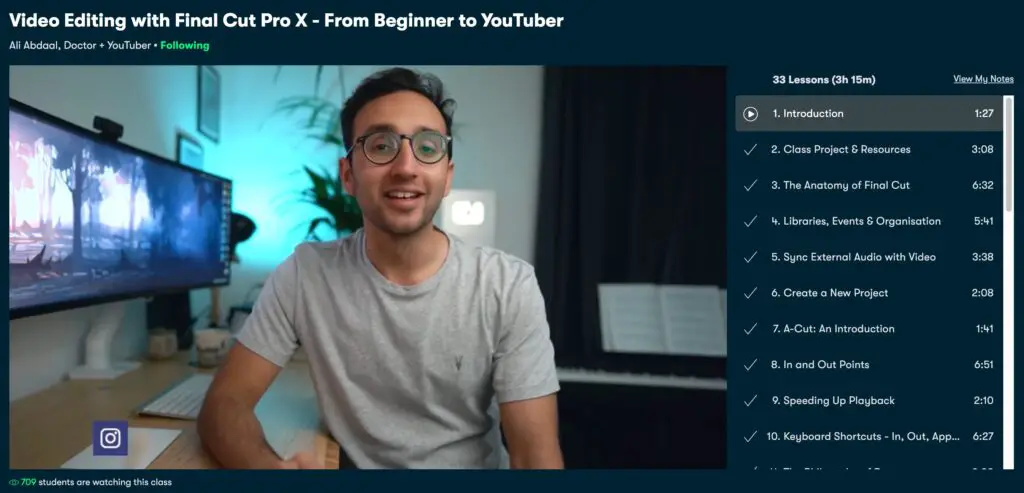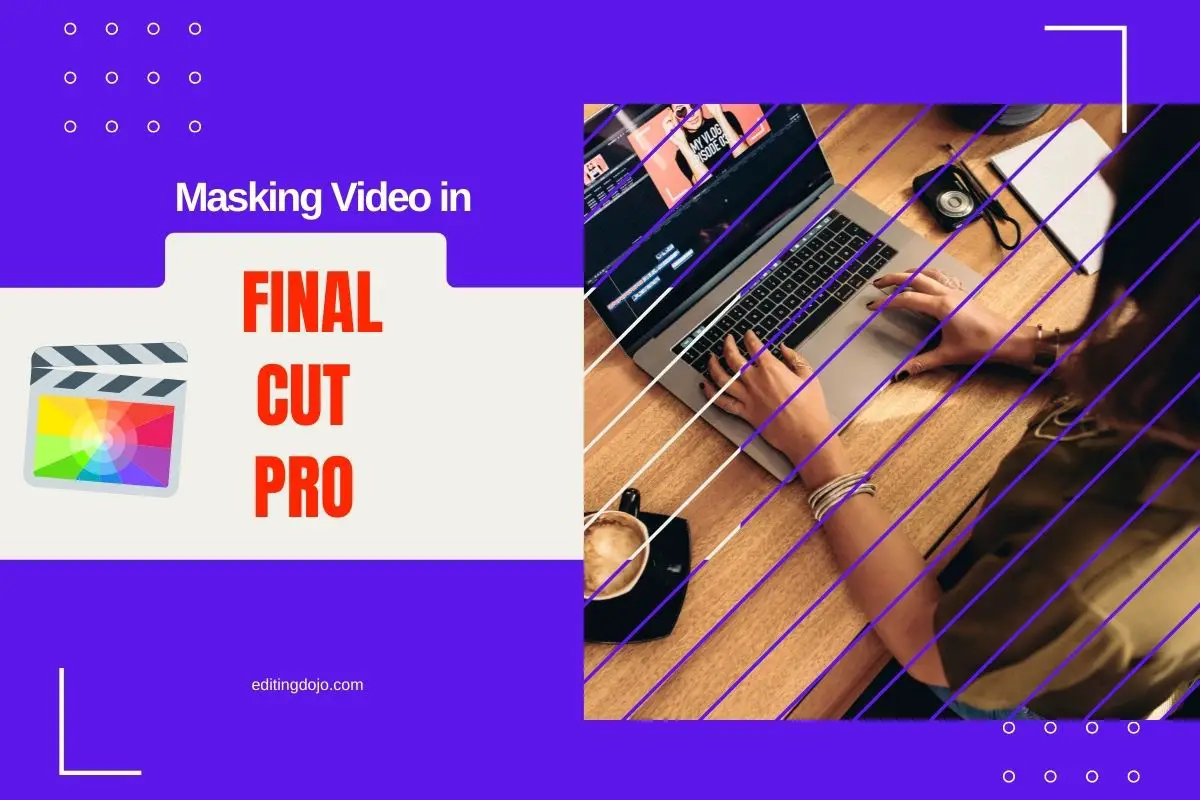If you’re just progressing from using iMovie to using Final Cut Pro, you may find yourself lost with all the additional features of this new software. One of the most useful options available in Final Cut Pro is the ability to draw masks on your video – but how do you go about creating this mask?
In this article, I’ll help you understand the process of creating a mask in Final Cut Pro in further detail. I’ll also explain what a mask is and why masks are helpful.
If you are looking to master Final Cut Pro or any other applications in the video editing space, I highly recommend that you check out SkillShare. SkillShare offers a ton of great courses you can take for one low monthly fee.

I personally recommend Ali Abdaal’s Video Editing with Final Cut Pro X course. Ali does a great job of layering in each concept in a very easy-to-learn way that will have you becoming a Final Cut Pro ninja in no time.
Making a Mask in Final Cut Pro
Enclosed below are the steps in masking video in Final Cut Pro:
- Mark the section of the clip you want to make transparent.
- Choose the shape of the mask.
- Adjust the mask.
- Experiment with other masking effects.
Mark the Section of the Clip You Want To Make Transparent
Once you add the clip you want to work on to your workspace in Final Cut Pro, the next step is to select the section that you want to apply the mask to. To select the section, move the playhead to the position that marks the start of the part of the clip you’ll be editing.
Choose the Shape of the Mask
If you’ve never used the mask tool previously, it’s best to start with using the prebuilt mask shapes. Once you’ve gained experience with the pre-loaded shapes, you can then use other masking effects (which I’ll discuss below).
To choose the shape, you’ll need to:
- Open the effects browser. It should be at the top-right corner of the timeline. If you can’t find it, you can also open it by pressing Command-5.
- Find and open the Masks category.
- Click on “Shape Mask”
- Apply the mask by either dragging the mask to the clip or double-clicking the thumbnail you selected in the previous step.
- Adjust the Mask
There are numerous parameters through which you can adjust your new mask. Some options include:
- Changing the position of the shape.
- Changing the width or height of the shape.
- Rotating the shape.
- Adjusting the curvature of the shape. This parameter allows you to change the shape of the mask – available shapes range from a rectangle to a circle.
- Controlling how soft the edges of the shape are.
Adjust the Mask
You can also adjust the mask via on-screen controls. You can refer to this video by Serge M on YouTube to get a better idea of how to adjust a mask in Final Cut Pro:
Experiment With Other Masking Effects
As mentioned above, the Shape Mask is only one way to create a mask in Final Cut Pro. Once you’re comfortable with this tool, you can then move on to trying some of the other masking options. These include:
- Graduated Mask: This allows you to create a mask with a gradient, which moves from transparent to opaque.
- Image Mask: You can use this mask option to create different areas of transparency in a single clip. You can highlight a section, make an area brighter, or even layer different images onto your clip.
- Vignette Mask: The mask you create in this option will have graduated edges. Additionally, it will be shaped like a horizontal ellipse.
- Effect Mask: This allows you to combine masks with other effects. This, in turn, gives you control over which sections of the clip are affected by the chosen effect.
- Draw Mask: This is the most complex type of mask. It allows you to create a custom mask in a shape that you want and is especially helpful for irregular shapes.
If you are looking to master rendering video in Final Cut Pro, check out our detailed guide to rendering video in Final Cut Pro.
How To Make a Custom Mask in Final Cut Pro
To make a custom mask in Final Cut Pro, you’ll need to:
- Open the effects browser. It should be at the top-right corner of the timeline. If you can’t find it, you can also open it by pressing Command-5.
- Find and open the Masks category.
- Click on “Draw Mask.”
- Drag and drop the thumbnail over the click.
- Click on a chosen section in the viewer to add a control point to the clip.
- Add control points until you’ve selected the shape you want. You can add as many control points as necessary to get the shape you want. You can complete the mask by selecting the original control point. If you need to reposition a control point after the mask has been closed, simply click and drag it as necessary.
- Adjust the settings.
You can also refer to this YouTube video by Serge M to get a better idea of how to make custom masks in Final Cut Pro:
What Is a Mask in Video Editing?
A mask in video editing is a tool that allows you to edit different sections of the same clip independently. You can use a mask to create different filters and effects for different areas of the clip. You can also use it to layer media above or below your clip.
Wondering how to keyframe video in Final Cut Pro? You have to check out our Complete Guide to Keyframing in Final Cut Pro.
Why Use Masking in Final Cut Pro?
Masking lets you create unique video effects, including combining two (or more) clips for a more cohesive result. With the help of masks, you can create movie-worthy effects from the comfort of your own home, including cloning objects, blurring faces, and modifying your footage.
Want to learn how to loop video in Final Cut Pro? Check out our Detailed Guide to Looping Video in Final Cut Pro.
Final Thoughts
While creating a mask may seem challenging the first time you try it, Final Cut Pro makes the process as simple as possible. Once you’ve created your first few masks, you can experiment with adding them to your video editing repertoire for more professional, polished videos.
Looking to master working with video clips in Final Cut Pro? We have you covered with our Ultimate Guide to Working with Video Clips in Final Cut Pro.
If you are looking to improve your video editing game, you must check out the mKeynote with iJustine Final Cut Pro plugin. It provides more than 100 clean, well-designed presets. For more information on the mKeynote plugin, click the link below:
Sources
- Pinnacle: Pinnacle Studio: Video Masking: What is video masking?
- Videomaker: You need to know these 4 video masking techniques
- Apple: Create simple shape masks in Final Cut Pro
- Apple: Intro to masking in Final Cut Pro
- Apple: Intro to effect masking in Final Cut Pro
- Cyberlink: How to Use Masks to Create Cool Video Effects


